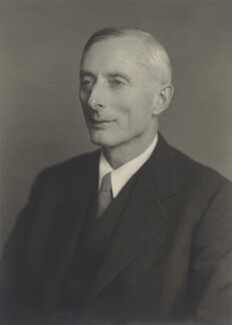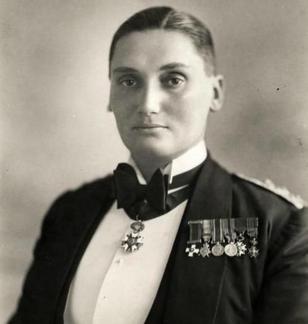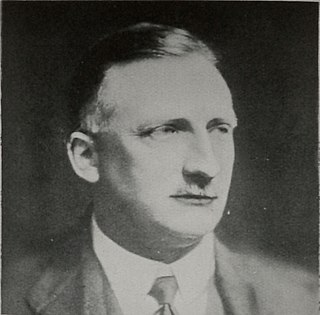Related Research Articles

The British Union of Fascists (BUF) was a British fascist political party formed in 1932 by Oswald Mosley. Mosley changed its name to the British Union of Fascists and National Socialists in 1936 and, in 1937, to the British Union. In 1939, following the start of the Second World War, the party was proscribed by the British government and in 1940 it was disbanded.

Arnold Spencer Leese was a British fascist politician. Leese was initially prominent as a veterinary expert on camels. A virulent anti-Semite, he led his own fascist movement, the Imperial Fascist League, and was a prolific author and publisher of polemics both before and after the Second World War.

The Imperial Fascist League (IFL) was a British fascist political movement founded by Arnold Leese in 1929 after he broke away from the British Fascists. It included a blackshirted paramilitary arm called the Fascists Legion, modelled after the Italian Fascists. The group espoused antisemitism and the dominance of the 'Aryan race' in a 'Racial Fascist Corporate State', especially after Leese met Nazi Party propagandist Julius Streicher, the virulently racist publisher of Der Stürmer; the group later indirectly received funding from the Nazis. Although it had only between 150 and 500 members at maximum, its public profile was higher than its membership numbers would indicate.

The National Socialist League (NSL) was a short-lived Nazi political movement in the United Kingdom immediately prior to the Second World War.

John Warburton Beckett was a British politician who was a Labour Party MP from 1924 to 1931. During the 1930s, he joined the fascist movement, first in the British Union of Fascists and later as a founder of the National Socialist League. During World War II, he was interned in Britain.
The Nordic League (NL) was a far-right organisation in the United Kingdom from 1935 to 1939 that sought to serve as a co-ordinating body for the various extremist movements whilst also seeking to promote Nazism. The League was a private organisation that did not organise any public events.

Hastings William Sackville Russell, 12th Duke of Bedford was a British peer. He was born at Cairnsmore House, Minnigaff, Kirkcudbrightshire, the son of Herbrand Russell, 11th Duke of Bedford, and his wife Mary Du Caurroy Tribe, the aviator and ornithologist. He was known for both his career as a naturalist and for his involvement in far-right politics.

Rotha Beryl Lintorn Lintorn-Orman was the founder of the British Fascisti, the first avowedly fascist movement to appear in British politics.

Alexander Raven Thomson, usually referred to as Raven, was a Scottish politician and philosopher. He joined the British Union of Fascists in 1933 and remained a follower of Oswald Mosley for the rest of his life. Thomson was considered to be the party's chief ideologue and has been described as the "Alfred Rosenberg of British fascism".
The British People's Party (BPP) was a British far-right political party founded in 1939 and led by ex-British Union of Fascists (BUF) member and Labour Party Member of Parliament John Beckett.

Victor Barker, born Lillias Irma Valerie Barker and called Valerie Arkell-Smith after marriage and who also went by the pseudonyms John Hill and Geoffrey Norton, was a transgender man who is notable for having married a woman. He was an officer of the National Fascisti, as well as a bankrupt and a convicted criminal.
The British Brothers' League (BBL) was a British anti-immigration, extraparliamentary, pressure group, the "largest and best organised" of its time. Described as proto-fascist, the group attempted to organise along paramilitary lines.
Robert Forgan was a British politician who was a close associate of Oswald Mosley.
The Organisation for the Maintenance of Supplies was a British right-wing movement, established in 1925 to provide volunteers in the event of a general strike. During the General Strike of 1926, it was taken over by the government to provide vital services, such as transport and communications.

Robert Byron Drury Blakeney, generally known as R. B. D. Blakeney, was a British Army officer and fascist politician. After a career with the Royal Engineers, Blakeney went on to serve as President of the British Fascists.
British fascism is the form of fascism which is promoted by some political parties and movements in the United Kingdom. It is based on British ultranationalism and imperialism and had aspects of Italian fascism and Nazism both before and after World War II.
Neil Lanfear Maclean Francis Hawkins was a British writer and politician who was a leading proponent of British fascism in the United Kingdom both before and after the Second World War. He played a leading role in the British Union of Fascists and controlled the organisational structure of the movement.

The British Fascists, formed in 1923, was the first political organisation in the United Kingdom to claim the label of fascist, although the group had little ideological unity apart from anti-socialism for much of its existence, and was strongly associated with conservatism. William Joyce, Neil Francis Hawkins, Maxwell Knight and Arnold Leese were amongst those to have passed through the movement as members and activists.
The Militant Christian Patriots (MCP) were a short-lived but influential anti-Semitic organisation active in the United Kingdom immediately prior to the Second World War. It played a central role in the ultimately unsuccessful attempts to keep the UK out of any European war.
References
- 1 2 Benewick 1969, p. 36.
- 1 2 Macklin 2020.
- ↑ Benewick 1969, p. 37.
- ↑ Pugh 2006, p. 53.
- ↑ Griffiths 1983, p. 88.
- ↑ J.A. Cole, Lord Haw-Haw: The Full Story of William Joyce, Faber & Faber, 1987, p. 31
- ↑ Benewick 1969, p. 38.
- 1 2 Thurlow 1987, p. 54.
- 1 2 Dorril 2007, p. 199.
- ↑ Pugh 2006, p. 66.
- ↑ Pugh 2006, p. 99.
- ↑ Pugh 2006, p. 69.
- ↑ Pugh 2006, p. 54.
- ↑ Dorril 2007, p. 184.
- ↑ Benewick 1969, p. 31.
Bibliography
- Benewick, Robert (1969). Political Violence & Public Order: A Study of British Fascism. Allen Lane. ISBN 978-0713900859.
- Dorril, Stephen (2007). Blackshirt: Sir Oswald Mosley and British Fascism. Penguin Books. ISBN 978-0-14-025821-9.
- Griffiths, Richard (1983). Fellow Travellers of the Right: British Enthusiasts for Nazi Germany, 1933-9. Oxford University Press. ISBN 978-0-19-285116-1.
- Macklin, Graham (2020). Failed Führers: A History of Britain's Extreme Right. Routledge. ISBN 978-1-317-44880-8.
- Pugh, Martin (2006). Hurrah For The Blackshirts!: Fascists and Fascism in Britain Between the Wars. Random House. ISBN 978-1-4481-6287-1.
- Thurlow, Richard C. (1987). Fascism in Britain: A History, 1918–1985. Blackwell. ISBN 978-0-631-13618-7.